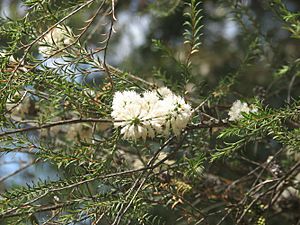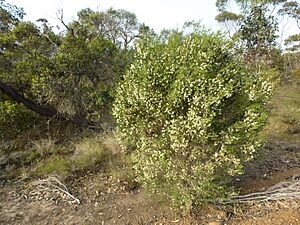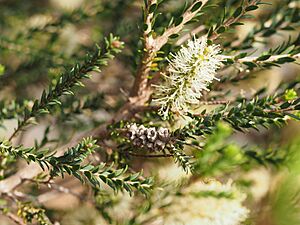Mohan facts for kids
Quick facts for kids Mohan |
|
|---|---|
 |
|
| Melaleuca viminea growing in the Maranoa Gardens, Victoria | |
| Scientific classification | |
| Genus: |
Melaleuca
|
| Species: |
viminea
|
| Synonyms | |
|
Myrtoleucodendron vimineum (Lindl.) Kuntze |
|
The Melaleuca viminea, also known as mohan, is a special plant from the myrtle family called Myrtaceae. It grows naturally only in the south-west part of Western Australia. This plant can be a small, bushy shrub or even a small tree. It has also started growing on its own in some areas of southern Victoria.
Contents
What Does Mohan Look Like?
The mohan plant can grow to be about 0.5 to 15 meters (about 1.5 to 50 feet) tall. It has bark that feels like paper or has lots of fibers.
Leaves, Flowers, and Fruit
Its leaves grow in pairs, one across from the other. Each leaf is usually about 3 to 20 millimeters (0.1 to 0.8 inches) long and 0.6 to 2 millimeters (0.02 to 0.08 inches) wide. They are long and thin, or narrow and oval-shaped, and they come to a point at the end.
The flowers of the mohan plant grow in groups at the ends of the branches. These flower heads are about 25 millimeters (1 inch) wide and can have anywhere from 5 to 50 small white or cream-colored flowers. Inside each flower, there are five groups of stamens (the parts that make pollen), with 3 to 16 stamens in each group. You can see these flowers from July to November, and some people say they have a strong, sweet smell. After the flowers, the plant makes small, woody seed pods that are about 2 to 4 millimeters (0.08 to 0.16 inches) long.

Plant Names and Types
This plant was first officially described in 1839 by a person named John Lindley. He wrote about it in his book, A sketch of the vegetation of the Swan River Colony. The second part of its scientific name, viminea, is a Latin word that means "bendy" or "willowy." This probably describes how some parts of the plant look.
There are three slightly different types, or subspecies, of Melaleuca viminea:
- M. viminea subsp. appressa: This type has small leaves that lie flat against the branches. It grows in three separate areas: Ongerup, Mt Burdett, and Yilgarn districts.
- M. viminea subsp. demissa: This type is mostly found in the Walpole-Manypeaks area.
- M. viminea subsp. viminea: This is the most common type. It grows from the Kalbarri area south to Busselton and Albany, and east to Muntadgin and Fitzgerald River. This is also the type that has started growing on its own in southern Victoria.
Where Mohan Grows
The mohan plant is found all over the south-west part of Western Australia. It likes to grow in sandy or clay soils. You can often find it near rivers, in areas that get wet in winter, along rocky coastlines, and on flat lands.
How Mohan is Protected
The Government of Western Australia's Department of Parks and Wildlife says that Melaleuca viminea is "not threatened." This means there are enough of these plants, and they are not in danger of disappearing.



